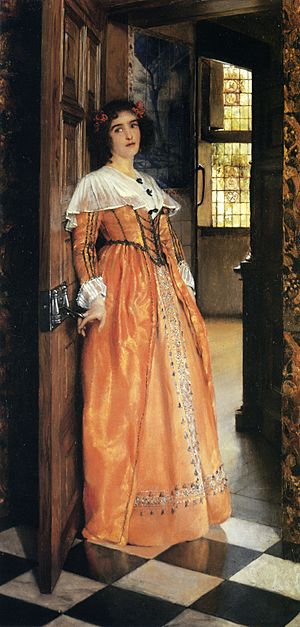Laura Theresa Alma-Tadema facts for kids
Quick facts for kids
Laura Theresa, Lady Alma-Tadema
|
|
|---|---|

Portrait by Lena Carroll
|
|
| Born |
Laura Theresa Epps
16 April 1852 London, England
|
| Died | 15 August 1909 (aged 57) Hindhead, Surrey, England
|
| Known for | Genre painting |
| Spouse(s) | |
| Awards |
|
Laura Theresa, Lady Alma-Tadema (born Epps; 16 April 1852 – 15 August 1909) was an English painter. She was known for her paintings of everyday scenes, especially those showing women and children. She showed eighteen of her paintings at the Royal Academy of Arts. Her husband, Sir Lawrence Alma-Tadema, was also a famous painter.
Contents
Her Life Story
Laura was the daughter of Dr. George Napoleon Epps. Her two sisters, Emily and Ellen, were also painters. Emily studied with John Brett, a Pre-Raphaelite artist. Ellen studied with Ford Madox Brown, another well-known painter.
Laura first met Lawrence Alma-Tadema in December 1869. She was 17, and he was 33. His first wife had passed away earlier that year. Lawrence fell in love with Laura right away. He decided to move to England because his art sold well there, and Laura lived in London. He moved when the Franco-Prussian War started in July 1870.
Lawrence arrived in London in September 1870 with his young daughters. He quickly contacted Laura Epps. He arranged to give her painting lessons. During one of these lessons, he asked her to marry him. Laura was 18 and Lawrence was 34, so her father was not sure at first. Dr. Epps finally agreed, but only if they waited to get to know each other better.
They married in July 1871. Their marriage was happy and lasted a long time. Laura became a stepmother to Lawrence's daughters, Laurence and Anna.
Her Art Career
Laura Alma-Tadema had her first art success in 1873 at the Paris Salon. In 1878, she was one of only two English women artists to show her work at the Paris International Exhibition. She also showed her paintings at the Royal Academy of Arts starting in 1873. Her work was also seen at the Grosvenor Gallery and other places in London.
In 1893, she showed her art at the World's Columbian Exposition in Chicago, Illinois. She sometimes worked as an illustrator, drawing pictures for The English Illustrated Magazine. She was also known for hosting parties at her homes in London.
Laura Alma-Tadema passed away on 15 August 1909. A newspaper article said she had been ill and returned from Germany feeling very weak. She went to a place in Hindhead to rest, but her illness suddenly got worse. She passed away peacefully after being unconscious for many hours. The year after she died, a special exhibition of her paintings was held to remember her work.
Her Painting Style
Laura Alma-Tadema was known for her sweet and emotional paintings. She often painted everyday scenes of women and children. Many of her paintings looked like they were set in the 17th-century Netherlands. Examples include Love's Beginning, Hush-a-bye, The Carol, At the Doorway (around 1898, shown here), and Sunshine.
She also painted some classical scenes and landscapes, like her husband. However, her main inspiration came from 17th-century Dutch art. She studied the works of famous Dutch painters like Vermeer and de Hooch during her trips to the Netherlands. Like her husband, Laura Alma-Tadema gave her paintings "Opus numbers" to keep track of them in order.
How She Was Shown in Art
Laura Alma-Tadema was often painted by her husband after they married. The Women of Amphissa from 1887 is a famous example. She was also shown in a small statue by Amendola in 1879. There was a bust (a sculpture of her head and shoulders) by Jules Dalou in 1876, and a portrait painting by Jules Bastien-Lepage.
Some of Her Paintings
- Always Welcome: This painting shows a child at her mother's sick-bed. It is kept at the Russell-Cotes Art Gallery & Museum.
- Ruin (and children): This is an Italian-style scene. It is also at the Russell-Cotes Art Gallery & Museum.
- Hawking - Medieval: This painting is at the Bury Art Museum.
- Mamma's chair (1873): This was her "Opus V" painting.
- Sweet Industry (1904): This painting shows women weaving. It is at the Manchester Art Gallery.
- George Eliot (pencil portrait, 1877): This is a drawing of the famous writer George Eliot. It is at the National Portrait Gallery.
- A Knock at the Door (1897): This painting is at the Currier Museum of Art in Manchester, New Hampshire.
Paintings Shown at the Royal Academy
- Mamma's Chair (1873)
- A Bird-cage (1875)
- A Blue Stocking (1877)
- A Good Book (1880)
- Amber and Opal (1880)
- Winter (1881)
- Asleep (1882)
- Saying Grace (1884)
- Self Help (1885)
- Nothing venture, nothing have (1888)
- The Pet Goldfish (1890)
- Hush-a-bye (1892)
- Satisfaction Persuasion (1893)
- The Pain of Parting (1895)
- A Carol (1896)
- Emblemata (1906)
- Peacemaking (1907)
- Sigh no more, Ladies (1909)
See also
 In Spanish: Laura Theresa Alma-Tadema para niños
In Spanish: Laura Theresa Alma-Tadema para niños



